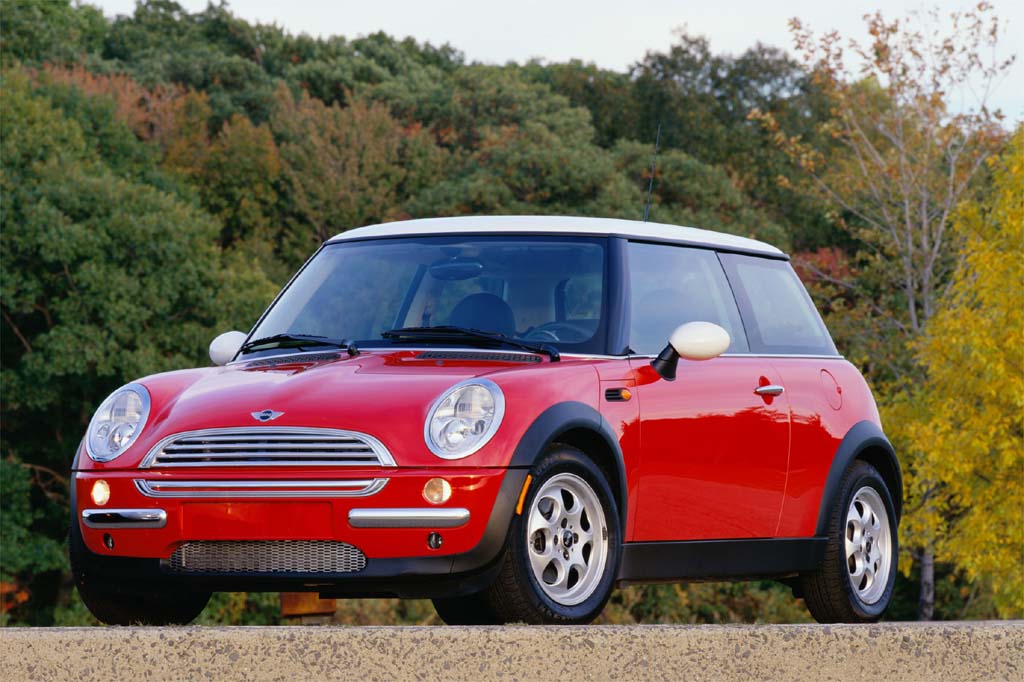| Sporty/performance car; Built in England |
|
|
| Good condition price range: $5,300 – $13,800* |

2002 MINI Cooper 2-door hatchback

2002 MINI Cooper 2-door hatchback

2002 MINI Cooper interior

2003 MINI Cooper

2004 MINI Cooper
| Pros: |
|
| Cons: |
|
Brimming with character, and available with a dizzying array of personalizing accessories, the Cooper is also an exceedingly well-mannered small car. It’s really a sport coupe rendered in the smallest scale. Sophisticated driving dynamics are spoiled only by a ride that too easily becomes harsh on imperfect pavement. Also, the base model has no surplus of power.
Overview
All-new in 2002, this two-door hatchback had the looks and spirit of Britain’s iconic 1959-2000 Mini. Yet, it was chiefly a BMW design built at the German company’s plant in England.
The front-wheel-drive Mini was positioned as a sporty coupe rather than an economy subcompact. Seating four within a boxy, retro-style body, it was among the smallest cars sold in the U.S. Specifically, the Mini was some 18 inches shorter and 400 pounds lighter (but 8 inches wider) than a Volkswagen New Beetle.
Two models were offered, both with a BMW-developed 1.6-liter four-cylinder engine. The base Mini Cooper got a 115-horsepower engine, while a supercharged version in the Cooper S developed 163 horsepower. A manual transmission was standard–a five-speed for the Cooper and a six-speed for the Cooper S. The base Cooper could be equipped with an optional continuously variable automatic transmission (CVT), with a manual mode providing six separate virtual “gear ratios.”
Standard equipment included antilock four-wheel disc brakes, front torso side airbags and front/rear head-protecting side airbags, a tire-pressure monitor, and remote keyless entry. Air conditioning, power windows, a CD player, and a 50/50 split-fold rear seat also were standard.
The Cooper S got a functional hood scoop and sport suspension, with 16-inch run-flat tires versus 15s (17-inch wheels were an S option).
The S suspension and wheels were available for the regular Cooper, as was a less-aggressive sport suspension. Options for both included antiskid control, Xenon headlamps, navigation and rear-obstacle warning systems, a sunroof, wood-and-leather interior trim, and heated seats.
Yearly Updates
| 2003 Cooper Partly because it had been introduced late in the 2002 model year, the trendy Mini Cooper was virtually unchanged for 2003. Sport Package options included an antiskid system and increased wheels size to 17 inches on the Cooper S, or 16-inch on the base Cooper. Dealer-applied Union Jack roof graphics recalled the original Minis; checkered and American-flag designs also were offered. For 2003, the standard CD player gained a port for plugging in an auxiliary MP3 player. Late in the 2003 model year, a John Cooper Works tuning kit became available, boosting output from the Cooper S engine to 200 horsepower. |
| 2004 Cooper Changes were few in the Mini’s third season. Standard equipment now included a digital speed readout under the tachometer (supplementing the regular central speedometer), as well as a rear power socket. Optional Sport seats now were offered in beige leather, in addition to black and blue. |
| 2005 Cooper A convertible body style joins Mini Cooper’s 2-dr hatchback for 2005. The convertible has a power top with heated glass rear window and, like the hatchback, seats four. Convertibles get front side airbags that protect the head and torso, rear obstacle detection, and a sunroof mode, which opens the convertible top part of the way. For ’05, all Minis get appearance revisions to headlights, taillights, and grille. |
| 2006 Cooper No significant changes for the Cooper for 2006. |
